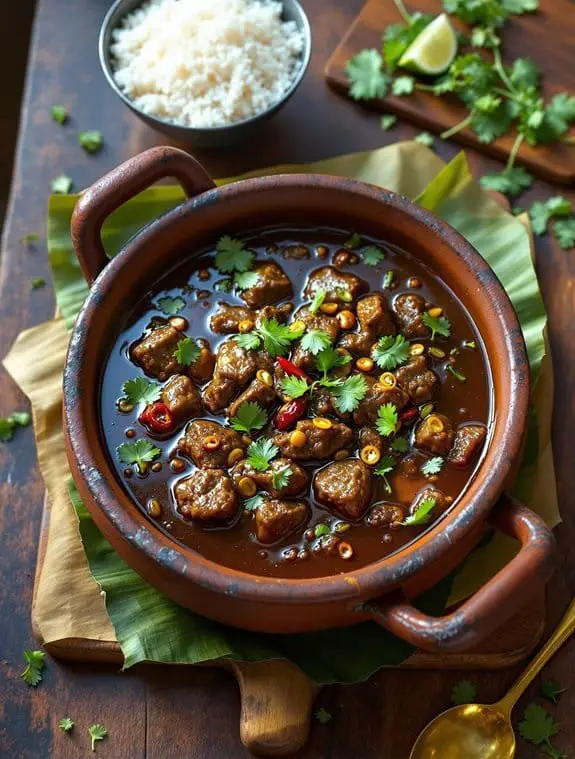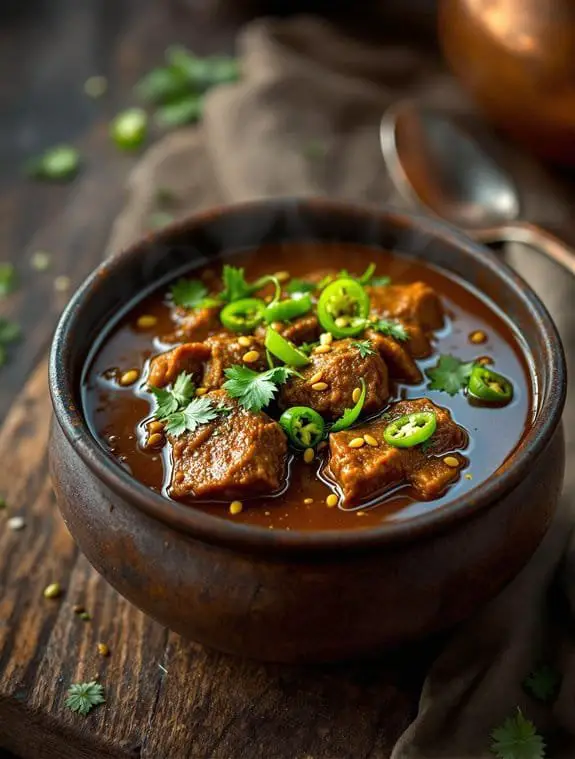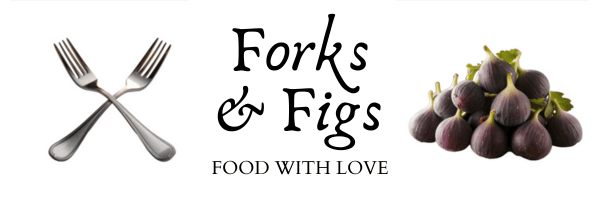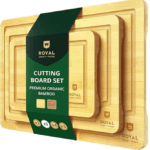Spicy Kerala-Style Beef Curry Recipe: A South Indian Classic

I’m convinced that Kerala-style beef curry might just be the most underrated dish in Indian cuisine, and honestly, I can’t figure out why it doesn’t get the same attention as butter chicken or tikka masala. Maybe it’s because people get intimidated by the long list of spices, or perhaps they’ve never experienced that magical moment when coconut oil hits curry leaves and the entire kitchen transforms into an aromatic paradise that’ll make your neighbors start asking questions.
Why You’ll Love this Spicy Kerala-Style Beef Curry
When you’re craving something that’ll wake up your taste buds and transport you straight to the spice markets of Kerala, this beef curry delivers every single time.
I’m talking about tender chunks of beef swimming in a coconut-scented gravy that’s got more personality than your chatty neighbor.
What makes this recipe special? It’s the perfect storm of aromatic spices, tangy tamarind, and that magical combination of mustard seeds crackling in coconut oil.
You’ll get layers of flavor that keep building with each bite, plus your kitchen will smell absolutely incredible for hours.
What Ingredients are in Spicy Kerala-Style Beef Curry?
Let me break down exactly what goes into this aromatic, soul-warming Kerala beef curry that’s about to become your new obsession. We’re working with a beautiful mix of whole spices, aromatics, and that all-important coconut oil that gives this dish its distinctive South Indian character.
The ingredient list might look long, but trust me, most of these are pantry staples you probably already have lurking in your spice cabinet. The real stars here are the warming spices like garam masala and coriander, plus that tangy tamarind paste that gives the curry its signature depth.
Ingredients:
- 1 kg beef chunks (chuck steak or stewing beef)
- 2 tbsp coconut oil
- 1 tsp black mustard seeds
- 1 tsp fennel seeds
- 10 curry leaves
- 2 red onions, sliced
- 2 green chillies, chopped
- 4 garlic cloves, crushed
- 3 tsp grated ginger
- 1 tsp turmeric powder
- 1 tsp freshly ground black pepper
- 2 tsp Kashmiri chilli powder
- 2 tsp ground coriander
- 1 tsp garam masala
- 1 tbsp tamarind paste
- 1 tin (400g) chopped tomatoes or 3 large ripe tomatoes, chopped
- Salt to taste
- 250 ml water
About These Ingredients
The coconut oil is absolutely non-negotiable here. Regular vegetable oil just won’t give you that authentic Kerala flavor profile you’re after. If you can’t find fresh curry leaves, some Indian grocery stores sell them frozen, which works beautifully.
Don’t stress if you can’t locate Kashmiri chilli powder specifically. You can substitute with regular chilli powder, but use a bit less since Kashmiri tends to be milder and more about the gorgeous red color than pure heat.
For the beef, chuck steak or any good stewing cut works perfectly because the long, slow cooking process will break down those tough fibers into melt-in-your-mouth tenderness. And about that tamarind paste, it’s what gives this curry its distinctive tangy backbone, so definitely don’t skip it.
How to Make this Spicy Kerala-Style Beef Curry

Making this Kerala beef curry is honestly one of those cooking experiences where your kitchen starts smelling like heaven about halfway through, and you’ll find yourself hovering around the stove just breathing it all in. The process is surprisingly straightforward, even if the ingredient list made you raise an eyebrow.
Start by heating those 2 tablespoons of coconut oil in a heavy-bottomed pot or Dutch oven over medium heat. Once it’s shimmering, toss in your 1 teaspoon each of black mustard seeds and fennel seeds, along with those 10 curry leaves. This is where the magic begins, because these seeds will start crackling and popping like tiny fireworks, releasing this incredible aromatic base that’s going to perfume your entire curry.
When the seeds stop their little dance party, add your 2 sliced red onions, a pinch of salt, and those 2 chopped green chillies. You want to sauté this mixture until the onions turn golden and soft, which usually takes about 5 to 7 minutes. The salt helps draw out the moisture from the onions, so they caramelize beautifully instead of just steaming.
Next comes the aromatics parade. Add your 4 crushed garlic cloves and 3 teaspoons of grated ginger to the pot, stirring everything around for about a minute until your kitchen smells absolutely divine. Then it’s time for the spice party: add that 1 teaspoon of turmeric powder, 1 teaspoon of freshly ground black pepper, 2 teaspoons of Kashmiri chilli powder, 2 teaspoons of ground coriander, and 1 teaspoon of garam masala.
This is where things get a bit intense, because you need to cook these spices for about 3 to 4 minutes, stirring constantly so they don’t burn. The spices will become incredibly fragrant and toasted, which is exactly what you want. If they start sticking to the bottom, add just a splash of water to loosen things up.
Now for the star of the show: add your 1 kg of beef chunks to the pot. Toss everything together so every piece of meat gets completely coated in that gorgeous spice mixture. Let the beef sauté for about 7 to 8 minutes, stirring occasionally. The meat will start browning and absorbing all those beautiful flavors.
Time to add the wet ingredients. Stir in that 1 tablespoon of tamarind paste first, which gives the curry its signature tangy kick. Then add your 400g tin of chopped tomatoes (or those 3 large fresh tomatoes if you’re going that route), followed by 250ml of water. Give everything a good stir and bring the whole mixture to a rolling boil.
Once it’s bubbling away happily, reduce the heat to low, clap a lid on that pot, and let it simmer for about 1.5 to 2 hours. This is the part where patience becomes your best friend, because slow cooking is what transforms tough beef chunks into fork-tender perfection. Check on it every 30 minutes or so, giving it a stir and adding more water if things look like they’re getting too thick.
You’ll know it’s done when the beef practically falls apart with a gentle prod from your spoon, and the sauce has thickened to a rich, glossy consistency that coats the back of a spoon. Taste for seasoning and add more salt if needed, because the beef will have absorbed quite a bit during that long, slow simmer.
Spicy Kerala-Style Beef Curry Substitutions and Variations
While this Kerala beef curry recipe is absolutely perfect as written, I totally get that sometimes you need to work with what’s actually sitting in your pantry, or maybe you’ve got dietary restrictions that require a little creative maneuvering.
No coconut oil? Ghee works beautifully, or even regular vegetable oil in a pinch. Missing fennel seeds? Just skip them, though they do add that subtle licorice note.
Can’t find Kashmiri chilli powder? Regular paprika mixed with cayenne does the trick. Want it vegetarian? Swap beef for chunks of eggplant or cauliflower, but reduce cooking time considerably.
What to Serve with Spicy Kerala-Style Beef Curry
Now that you’ve got this gorgeous, aromatic curry simmering away and filling your kitchen with those incredible spices, you’re probably wondering what’s going to make the perfect partner for all that rich, spicy goodness.
I’m reaching for fluffy basmati rice first – it’s practically mandatory with Kerala curry. The grains soak up that coconut-kissed sauce beautifully.
Appam, those bowl-shaped fermented rice pancakes, are my top choice if you can find them. They’re like edible sponges for curry.
Fresh naan or chapati work wonderfully too.
Don’t forget cooling yogurt or raita to tame the heat when things get intense.
Final Thoughts
There you have it – your complete guide to creating this absolutely divine Kerala-style beef curry that’ll have your taste buds doing a happy dance.
I’m telling you, once you master those fragrant spice layers and get that perfect coconut oil sizzle going, you’ll wonder why you ever settled for bland weeknight dinners.
Sure, it takes some patience, but isn’t good food always worth the wait?
This curry’s going to become your new secret weapon for impressing dinner guests. Trust me on this one.

Kerala-Style Beef Curry
Equipment
Ingredients
- 1 kg beef chunks chuck steak or stewing beef
- 2 tbsp coconut oil
- 1 tsp black mustard seeds
- 1 tsp fennel seeds
- 10 curry leaves
- 2 red onions sliced
- 2 green chillies chopped
- 4 garlic cloves crushed
- 3 tsp grated ginger
- 1 tsp turmeric powder
- 1 tsp freshly ground black pepper
- 2 tsp Kashmiri chilli powder
- 2 tsp ground coriander
- 1 tsp garam masala
- 1 tbsp tamarind paste
- 1 tin 400g chopped tomatoes or 3 large ripe tomatoes, chopped
- Salt to taste
- 250 ml water
Instructions
- Heat coconut oil in a heavy-bottomed pot over medium heat. Add mustard seeds, fennel seeds, and curry leaves. Cook until they begin crackling.
- Add sliced onions, a pinch of salt, and green chillies. Sauté until onions turn golden brown.
- Mix in crushed garlic, grated ginger, turmeric powder, black pepper, Kashmiri chilli powder, ground coriander, and garam masala. Cook for 3-4 minutes until fragrant.
- Add beef chunks and coat well with the spice mixture. Sauté for 7-8 minutes until beef is browned on all sides.
- Stir in tamarind paste, chopped tomatoes, and water. Bring to a boil.
- Reduce heat to low, cover, and simmer for 1-1.5 hours until beef is tender and sauce has thickened.
- Adjust seasoning with salt and serve hot with rice or bread.
Notes
Nutrition
Frequently Asked Questions
Can I Make Kerala Beef Curry in a Slow Cooker or Pressure Cooker?
I’d recommend using a pressure cooker for Kerala beef curry. After sautéing the spices and beef following steps 1-4, add remaining ingredients and pressure cook for 25-30 minutes for tender results.
How Long Does Leftover Kerala Beef Curry Last in the Refrigerator?
I’ll store your leftover Kerala beef curry in the refrigerator for 3-4 days maximum. I recommend keeping it in an airtight container and reheating thoroughly before serving to maintain food safety.
Is Kerala Beef Curry Supposed to Be Very Spicy and Hot?
I’d say Kerala beef curry has moderate heat rather than extreme spiciness. You’ll taste warmth from black pepper, green chillies, and Kashmiri chilli powder, but it’s balanced with aromatic spices.
What’s the Difference Between Kerala Beef Curry and Other Indian Beef Curries?
I’ll explain how Kerala beef curry differs from other Indian varieties. It uses coconut oil, curry leaves, and fennel seeds for distinct South Indian flavors, while northern curries typically feature cream, yogurt, and different spice blends.
Can I Freeze Kerala Beef Curry for Meal Prep Purposes?
I’d recommend freezing Kerala beef curry since it actually improves the flavors when reheated. You can store it for up to three months, and it’s perfect for convenient weeknight dinners.



